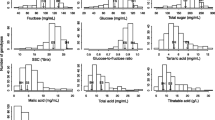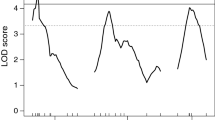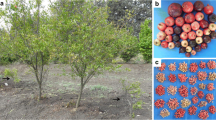Abstract
The optimal balance between sugar and acidity is an essential criterion to elaborate equilibrated and stable wines. The aim of this study was to locate quantitative trait loci (QTLs) for these traits using an F1 population derived from Monastrell and Syrah wine cultivars. Several parameters related to acidity were evaluated during six consecutive years by measuring total soluble solids, total acidity, malic acid, and tartaric acid. Three genetic maps were developed using 104 SSR (simple sequence repeat) and 146 SNP (single-nucleotide polymorphism) markers. The consensus map covered 1174 cM with 238 markers assembled in 19 linkage groups (LGs). Significant QTLs at the genome-wide level were detected, and, although they exhibited a large degree of instability from year to year, QTLs for the ratio of soluble solids to acidity (LG2) and malic acid (LG8) and the ratio of tartaric to malic acid (LG8) were stable in at least 2 years. Several annotated genes involved in sugar and acidity pathways co-located with the confidence intervals of these QTLs and are proposed as putative candidate genes for future studies of these traits.

Similar content being viewed by others
References
Adam-Blondon AF, Roux C, Claux D, Butterlin G, Merdinoglu D, This P (2004) Mapping 254 SSR markers on the Vitis vinifera genome: a tool for grape genetics. Theor Appl Genet 109:1017–1027. https://doi.org/10.1007/s00122-004-1704-y
Ban Y, Mitani N, Sato A, Kono A, Hayashi T (2016) Genetic dissection of quantitative trait loci for berry traits in interspecific hybrid grape (Vitis labruscana × Vitis vinifera). Euphytica 211:295–310. https://doi.org/10.1007/s10681-016-1737-8
Battilana J, Costantini L, Emanuelli F, Sevini F, Segala F, Moser S, Velasco R, Versini G, Grando MS (2009) The 1-deoxy-D-xylulose 5-phosphate synthase gene co-localizes with a major QTL affecting monoterpene content in grapevine. Theor Appl Genet 108:653–669. https://doi.org/10.1007/s0122-008-0927-8
Bayo-Canha A, Fernández-Fernández JI, Martínez-Cutillas A, Ruiz-García L (2012) Phenotypic segregation and relationships of agronomic traits in Monastrell x Syrah wine grape progeny. Euphytica 186:393–407. https://doi.org/10.1007/s10681-012-0622-3
Boopathi NM (2013) Genotyping of mapping population. In: Boopathi NM (ed) Genetic mapping and marker assisted selection. Basics, practice and benefits. Springer, India. ISBN 978-81-322-0957-7, pp 39–80
Cabezas JA, Cervera MT, Ruiz-García L, Carreño J, Martínez-Zapater JM (2006) A genetic analysis of seed and berry weight in grapevine. Genome 49:1572–1585. https://doi.org/10.1139/g06-122
Cabezas JA, Ibáñez J, Lijavetzky D, Vélez D, Bravo G, Rodríguez V, Carreño I, Jermakow AM, Carreño J, Ruiz-García L, Thomas MR, Martínez-Zapater JM (2011) A 48 SNP set for grapevine cultivar identification. BMC Plant Biol 11:153. https://doi.org/10.1186/1471-2229-11-153
Chakravarti A, Lasher LK, Reefer JE (1991) A maximum likelihood method for estimating genome length using genetic linkage data. Genetics 128:175–182
Chen J, Wang N, Fang L-C, Liang Z-C, Li S-H, Wu B-H (2015) Construction of a high-density genetic map and QTLs mapping for sugars and acids in grape berries. BMC Plant Biol 15:28. https://doi.org/10.1187/s12870-015-0428-2
Chialva C, Eichler E, Muñoz C, Lijavetzky D (2016) Development and use of biotechnology tools for grape functional analysis. In: Morata A, Loira I (eds) Grape and wine biotechnology. InTech, pp 75–101. https://doi.org/10.5772/64915
Cholet C, Claverol S, Claisse O, Rabot A, Osowsky A, Dumot V, Gerrari G, Gény L (2016) Tartaric acid pathways in Vitis vinifera L. (cv. Ugni blanc): a comparative study of two vintages with contrasted climatic conditions. BMC Plant Biol 16:144. https://doi.org/10.1186/s12870-016-0833-1
Cipriani G, Di Gaspero G, Canaguier A, Jusseaume J, Tassin J, Lemainque A, Thareau V, Adam-Blondon A-F, Testolin R (2011) Molecular linkage maps: strategies, resources and achievements. In: Adam-Blondon A-F, Martínez-Zapater JM, Kole C (eds) Genetics, genomics and breeding of grapes. Science Publishers, Enfield, pp 111–136
Conde C, Silva P, Fontes N, Dias ACP, Tavares RM, Sousa MJ, Agasse A, Delrot S, Gerós H (2007) Biochemical changes throughout grape berry development and fruit and wine quality. Food (Global Science Books) 1:1–22
Coombe BG (1992) Research on development and ripening of the grape berry. Am J Enol Vitic 43:101–110
Costantini L, Battilana J, Lamaj F, Fanizza G, Grando MS (2008) Berry and phenology-related traits in grapevine (Vitis vinifera L.): from quantitative trait loci to underlying genes. BMC Plant Biol 8:38
Cuéllar T, Azeem F, Andrianteranagna M, Pascaud F, Verdeil JL, Sentenac H, Zimmermann S, Gaillard I (2013) Potassium transport in developing fleshy fruits: the grapevine inward K+ channel Vvk1.2 is activated by CIPK-CBL complexes and induced in ripening berry flesh cells. Plant J 73:1006–1018. https://doi.org/10.1111/tpj.12092
Davies C, Robinson SP (2000) Differential screening indicates a dramatic change in mRNA profiles during grape berry ripening. Cloning and characterization of cDNAs encoding putative cell wall and stress response proteins. Plant Physiol 122:803–812. https://doi.org/10.1104/pp.122.3.803
De la Vega F, Lazaruk KD, Rhodes MD, Wenz MH (2005) Assessment of two flexible and compatible SNP genotyping platforms: TaqMan® SNP genotyping assays and the SNPlex™ genotyping system. Mutat Res 573:111–135. https://doi.org/10.1016/j.mrfmmm.2005.01.008
DeBolt S, Cook DR, Ford CM (2006) L-tartaric acid synthesis form vitamin C in higher plants. PNAS 103:5608–5613. https://doi.org/10.1073/pnas.0510864103
Doligez A, Bouquet A, Danglot Y, Lahogue F, Riaz S, Meredith CP, Edwards KJ, This P (2002) Genetic mapping of grapevine (Vitis vinifera L.) applied to the detection of QTLs for seedlessness and berry weight. Theor Appl Genet 105:780–795. https://doi.org/10.1007/s00122-002-0951-z
Doligez A, Adam-Blondon AF, Cipriani G, Di Gaspero G, Laucou V, Merdinoglu D, Meredith CP, Riaz S, Roux C, This P (2006) An integrated SSR map of grapevine based on five mapping populations. Theor Appl Genet 113:369–382. https://doi.org/10.1007/s00122-006-0295-1
Don RH, Cox PT, Wainwrigth BJ, Baker K, Mattick JS (1991) ‘Touchdown’ PCR to circumvent spurious priming during gene amplification. Nucleic Acids Res 19:4008
Duchêne E, Butterlin G, Claudel P, Dumas V, Jaegli N, Merdinoglu D (2009) A grapevine (Vitis vinifera L.) deoxy-D-xylulose synthase gene colocates with a major quantitative trait loci for terpenol content. Theor Appl Genet 118:541–552. https://doi.org/10.1007/s00122-008-0919-8
Duchêne E, Dumas V, Jaegli N, Merdinoglu D (2014) Genetic variability of descriptors for grapevine berry acidity in Riesling, Gewürztraminer and their progeny. Aust J Grape Wine Res 20:91–99. https://doi.org/10.1111/ajgw.12051
Gerber S, Rodolphe F (1994) An estimation of the genome length of maritime pine (Pinus pinaster Ati). Theor Appl Genet 88:289–292. https://doi.org/10.1007/BF00223634
Gladstones J (1992) Viticulture and environment. Winetitles, Adelaide
Grattapaglia D, Sederoff R (1994) Genetic linkage map of Eucalyptus grandis and Eucalyptus urophylla using pseudo-testcross: mapping strategy and RAPD markers. Genetics 137:1121–1137
Houel C, Chatbanyong R, Doligez A, Rienth M, Foria S, Luchaire N, Roux C, Adivèze A, Lopez G, Farnos M, Pellegrino A, This P, Romieu C, Torregrosa L (2015) Identification of stable QTLs for vegetative and reproductive traits in the microvine (Vitis vinifera L.) using a 18K Infinium chip. BMC Plant Biol 15:205. https://doi.org/10.1186/s12870-015-0588-0
Hulbert SH, Ilott TW, Legg EJ, Lincoln SE, Lander ES, Michelmore RW (1988) Genetic analysis of the fungus Bremia lactucae, using restriction fragment length polymorphisms. Genetics 120:947–958
Jackson RS (2008a) Chemical constituents of grapes and wine. In: Jackson RS (ed) Wine science: principles and applications, 3rd edn. Elsevier, Burlington, pp 270–331
Jackson RS (2008b) Site selection and climate. In: Jackson RS (ed) Wine science: principles and applications, 3rd edn. Elsevier, Burlington, pp 239–369
Jansen RC, Stam P (1994) High resolution of quantitative traits into multiple loci via interval mapping. Genetics 136:1447–1455
Jones GV, White MA, Cooper OR, Storchmann K (2005) Climate change and global wine quality. Clim Chang 73:319–343. https://doi.org/10.1007/s10584-005-4704-2
Kearsey MJ, Pooni HS (1996) Genes, genetic markers and maps. In: Kearsey MJ, Pooni HS (eds) The genetical analysis of quantitative traits. Stanley Thornes, UK. ISBN 0-7487-4082-1, pp 101–133
Kliewer WM (1966) Sugar and organic acids of Vitis vinifera. Plant Physiol 41:923–931. https://doi.org/10.1104/pp.41.6.923
Kliewer WM (1973) Berry composition of Vitis vinifera cultivars as influenced by photo- and nycto- temperatures during maturation. Amer Soc Hort Sci J 98:153–159
Kosambi DD (1944) The estimation of map distance from recombination values. Ann Eugenics 12:172–175
Lander E, Botstein D (1989) Mapping Mendelian factors underlying quantitative traits using RFLP linkage maps. Genetics 121:185–199
Lange K, Boehnke M (1982) How many polymorphic genes will it take to spam the human genome? Am J Hum Genet 34:842–845
Laucou V, Launay A, Bacilieri R, Lacombe T, Adam-Blondon AF, Bérard A, Chauveau A, de Andrés MT, Hausmann L, Ibáñez J, Le Paslier M-C, Maghradze D, Martinez-Zapater JM, Maul E, Ponnaiah M, Töpfer R, Péros J-P, Boursiquot J-M (2018) Extended diversity analysis of cultivated grapevine Vitis vinifera with 10K genome-wine SNPs. PLoS One 13:e0192540. https://doi.org/10.1371/journal.pone.0192540
Lechmann EL (1975) Nonparametrics. McGraw-Hill, New York
Lijavetzky D, Cabezas JA, Ibáñez A, Rodríguez V, Martínez-Zapater JM (2007) High throughput SNP discovery and genotyping in grapevine (Vitis vinifera L.) by combining a re-sequencing approach and SNPlex technology. BMC Genomics 8:424. https://doi.org/10.1186/1471-2164-8-424
Liu HF, Wu BH, Fan PG, Xu HY, Li SH (2007) Inheritance of sugars and acids in berries of grape (Vitis vinifera L.). Euphytica 153:99–107. https://doi.org/10.1007/s10681-006-9246-9
Lodhi MA, Daly MJ, Ye GN, Weeden NF, Reisch B (1995) A molecular marker based linkage map of Vitis. Genome 38:786–794. https://doi.org/10.1139/g95-100
Morreel K, Goeminne G, Storme V, Sterck L, Ralph J, Coppieters W, Breyne P, Steenackers M, Georges M, Messens E, Boerjan W (2006) Genetical metabolomics of flavonoid biosynthesis in Populus: a case study. Plant J 47:224–237
Or E, Baybik J, Sadka A, Saks Y (2000) Isolation of mitochondrial malate dehydrogenase and phosphoenolpyruvate carboxylase cDNA clones from grape berries and analysis of their expression pattern throughout berry development. J Plant Physiol 157:527–534. https://doi.org/10.1016/S0176-1617(00)8018-X
Pego JV, Smeekens SCM (2000) Plant fructokinases: a sweet family get-together. Trends Plant Sci 5:531–536. https://doi.org/10.1016/S1360-1385(00)01783-0
Pflieger S, Lefebvre V, Causse M (2001) The candidate gene approach in plant genetics: a review. Mol Breed 7:275–291. https://doi.org/10.1023/A:1011605013259
Riaz S, Dangl GS, Edwards KJ, Meredith CP (2004) A microsatellite marker based framework linkage map of Vitis vinifera L. Theor Appl Genet 108:864–872. https://doi.org/10.1007/s00122-003-1488-5
Sato A, Yamada M, Iwanami H, Hirakawa N (2000) Optimal spatial and temporal measurement repetition for reducing environmental variation of berry traits in grape breeding. Sci Hortic 85:75–83
Schnarrenberger C, Martin W (2002) Evolution of the enzymes of the citric acid cycle and the glyoxylate cycle of higher plants. Eur J Biochem 269:868–883. https://doi.org/10.1046/j.0014-2956.2001.02722.x
Sweetman C, Deluc LG, Cramer GR, Ford CM, Soole KL (2009) Regulation of malate metabolism in grape berry and other developing fruits. Phytochemistry 70:1329–1344. https://doi.org/10.1016/j.phytochem.2009.08.006
Terrier N, Glissant D, Grimplet J, Barrieu F, Abbal P, Couture C, Ageorges A, Atanassova R, Léon C, Renaudin JP, Dédadéchamp F, Romieu C, Delrot S, Hamdi S (2005) Isogene specific oligo array reveal multifaceted changes in gene expression during grape berry (Vitis vinifera L.) development. Planta 222:832. https://doi.org/10.1007/s00425-005-0017-y
Tobler AR, Short S, Andersen MR, Paner TM, Briggs JC, Lambert SM, Wu PP, Wang Y, Spoonde AY, Koehler RT, Peyret N, Chen C, Leong LN, Ma CN, Rosenblum BB, Day JP, Ziegle JS, De La Vega RM, Rhodes MD, Hennessy KM, Wenz HM (2005) The SNPlex genotyping system: a flexible and scalable platform for SNP genotyping. J Biomol Tech 16:398–406
Troggio M, Malacarne G, Coppola G, Segala C, Cartwright DA, Pindo M, Stefanini M, Mank R, Moroldo M, Morgante M, Grando MS, Velasco R (2007) A dense single-nucleotide polymorphism-based genetic linkage map of grapevine (Vitis vinifera L.) anchoring pinot noir bacterial artificial chromosome contigs. Genetics 176:2636–2650. https://doi.org/10.1534/genetics.106.067462
Van Ooijen JW, Voorrips RE (2001) JoinMap® 3.0: software for the calculation of genetic linkage maps. Plant Research International, Wageningen, The Netherlands
Van Ooijen JV, Boer MP, Jansen RC, Maliepaard C (2002) MapQTL® 4.0, software for the calculation of QTL position on genetic maps. Plant Research International, Wageningen, The Netherland
Viana AP, Riaz S, Walker MA (2013) Genetic dissection of agronomic traits within a segregating population of breeding table grapes. Genet Mol Res 12:951–964
Viana AP, Resende MDV, Riaz S, Walker MA (2016) Genome selection in fruit breeding: application to table grapes. Sci Agric 73:142–149. https://doi.org/10.1590/0103-9016-2014-0323
Voorrips RE (2002) MapChart: software for the graphical presentation of linkage maps and QTLs. J Hered 93:77–78. https://doi.org/10.1093/jhered/93.1.77
Walker AR, Lee E, Bogs J, McDavid DAJ, Thomas MR, Robinson SP (2007) White grapes arose through the mutation of two similar and adjacent regulatory genes. Plant J 49:772–785. https://doi.org/10.1111/j.1365-313X.2006.02997.x
Wei X, Sykes SR, Clingeleffer PR (2002) An investigation to estimate genetic parameters in CSIRO’s table grape breeding program. 2. Quality characteristics. Euphytica 128:343–351
Weinl S, Kudla J (2009) The CBL-CIPK Ca2+-decoding signaling network: function and perspectives. New Phytol 184:517–528. https://doi.org/10.1111/j.1469-8137.2009.02938.x
Welter LJ, Baydar NG, Akkurt M, Maul E, Eibach R, Töpfer R, Zyprian EM (2007) Genetic mapping and localization of quantitative trait loci affecting fungal disease resistance and leaf morphology in grapevine (Vitis vinifera L.). Mol Breed 20:359. https://doi.org/10.1007/s11032-007-9097-7
Wen J, Can VT, Zhang Y-M (2013) Multi-QTL mapping for quantitative traits using distorted markers. Mol Breed 31:395–404. https://doi.org/10.1007/s11032-012-9797-5
Xu S (2008) Quantitative trait locus mapping can benefit from segregation distortion. Genetics 180:2201–2208
Xu S, Hu Z (2009) Mapping quantitative trait loci using distorted markers. Int J Plant Genomics 2009:410825. https://doi.org/10.1155/2009/410825
Yang S, Fresnado-Ramírez J, Sun W, Manns DC, Sacks GL, Mansfield AK, Luby JJ, Londo JP, Reisch BI, Cadle-Davidson LE, Fennell AY (2016) Next generation mapping of enological traits in an F2 interspecific grapevine hybrid family. PLoS One 11:e0149560. https://doi.org/10.1371/journal.pine.0149560
Zenoni S, Ferrarini A, Giacomelli E, Xumerle L, Fasoli M, Malerba G, Bellin D, Pezzotti M, Delledonne M (2010) Characterization of transcriptional complexity during berry development in Vitis vinifera using RNA-Seq. Plant Physiol 152:1787–1795. https://doi.org/10.1104/pp.109.149716
Zhang L, Wang S, Li H, Deng Q, Zheng A, Li S, Li P, Li Z, Wang J (2010) Effects of missing marker and segregation distortion on QTL mapping in F2 populations. Theor Appl Genet 121:1071–1082
Zhao YH, Guo YS, Lin H, Liu ZD, Ma HF, Guo XW, Li K, Yang XX, Niu ZZ, Shi GG (2015) Quantitative trait locus analysis of grape weight and soluble solid content. Genet Mol Res 14:9872–9881. https://doi.org/10.4238/2015
Zhao YH, Su K, Guo YH, Ma HF, Guo XW (2016) Molecular genetic map construction and QTL analysis of fruit maturation period in grapevine. Genet Mol Res 15(2). https://doi.org/10.4238/gmr.15028040
Acknowledgments
The authors wish to thank A. Fuentes-Denia for technical assistance and J.A. Martínez-Jiménez for plant management in the field. We are also grateful to the research team of Dr. Stella Grando at the Centre for Research and Innovation, Fondazione Edmund Mach (FEM), in San Michele all’Adige (Italy), for their help in the development of new SNP-based markers. A. Bayo-Canha was a pre-doctoral fellow of the Instituto Murciano de Investigación y Desarrollo Agrario y Alimentario.
Funding
This study was financially supported by projects RTA2007-00043 and RTA2011-00029-C02-02 from the Instituto Nacional de Investigación y Tecnología Agraria y Alimentaria, co-financed by the European Regional Development Fund.
Author information
Authors and Affiliations
Corresponding author
Ethics declarations
Conflict of Interest
The authors declare that they have no conflict of interest.
Ethical Standards
This article does not contain any studies with human participants or animals performed by any of the authors.
Additional information
Publisher’s Note
Springer Nature remains neutral with regard to jurisdictional claims in published maps and institutional affiliations.
Rights and permissions
About this article
Cite this article
Bayo-Canha, A., Costantini, L., Fernández-Fernández, J.I. et al. QTLs Related to Berry Acidity Identified in a Wine Grapevine Population Grown in Warm Weather. Plant Mol Biol Rep 37, 157–169 (2019). https://doi.org/10.1007/s11105-019-01145-6
Published:
Issue Date:
DOI: https://doi.org/10.1007/s11105-019-01145-6




